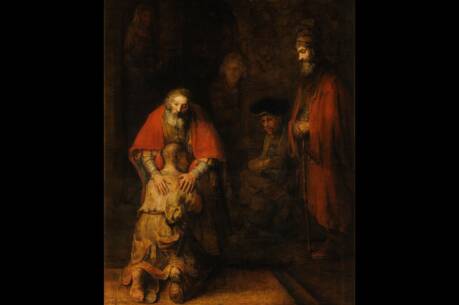A Real Holy Joe
As the celebration of the Incarnation nears, the readings echo with wonder and joy. Amid virtual despair about the future of the kingdom, Yahweh tells Ahaz to ask for a sign, which the king will not do, lest he tempt God. But Isaiah intervenes with an oracle of salvation. Life is affirmed at the doorstep of destruction; a virgin will bear a child and his name shall signify his destiny, God will be with us. The solemn introduction to Romans heralds the arrival of a descendant of David according to the flesh, who was established as the Son of God in power. The Gospel portrays the annunciation to Joseph that Mary, who was betrothed (that is, legally married) to Joseph, will bear a son with a double nameJesus, because he will save his people from their sins, and Emmanuel (God with us), in fulfillment of Isaiah’s prophecy.
In liturgy, art and devotion we rightly merge the infancy narratives of Matthew and Luke to create a Yuletide tapestry. Naturally Mary, the mother, and her child occupy center stage. Matthew, though, has another dimension, which is important for our time. The central human character in Matthew is Joseph. In contrast to Luke, not Mary but Joseph receives divine messages from angels and in dreams. Mary is most often spoken about and initiates no action, while Joseph’s obedience to God’s word appears at every critical juncture. Faced with doubt over Mary’s pregnancy, Joseph did as the angel commanded him and took his wife into his home. After the birth of the child, Joseph again receives a dream revelation and takes the child and his mother to Egypt to avoid the murderous actions of Herod, and after a third dream vision returns the family to Nazareth. In each case Joseph is the human agent by which Scripture is fulfilled. Yet, though Matthew and Luke present independent infancy narratives, there is wonderful parallelism. Mary and Joseph react in similar ways to angelic messages. Both are told not to fear in the face of a seemingly impossible future; both are told that the Holy Spirit has acted, and both are given a sign of God’s presence. Throughout the narratives, both hear the word of God and act upon it.
In Christian art Joseph is often portrayed more like Jesus’ grandfather or great-grandfather than like a parent. In a 17th-century painting by Guido Reni, Joseph, with gray hair and beard, lovingly holds the infant, who plays with his beard. One beautiful exception is El Greco’s Joseph, which portrays him as a vigorous young man with Jesus clinging to his legs, here a figure of trust and protection. The historical Joseph, a carpenter or stoneworker, was most likely young and vigorous, excited about a future with a woman he so loved that he would not invoke a harsh law against supposed adultery, but still followed the law to put her away quietly. Yet out of his shattered hopes would come forth one whom he would name Jesus and Emmanuel, God With Us.
Today, when parenting is both so challenging and so threatened, Joseph provides a wonderful image of a father. The future of his child unfolds in dreams; even though he cannot see what the future holds, he protects and cares for his family in the face of murder and exile; he is faithful to God’s word. He is called to a life of hard work providing for the son Mary will bear. When coupled with Luke’s portrait of Mary, Matthew’s Joseph provides a model of complementarity for parents today as they engage in that most divine of tasksbringing forth new life and guiding their sons and daughters along the way of Christ.
This article also appeared in print, under the headline “A Real Holy Joe,” in the December 17, 2001, issue.







